You can't solve for traffic
when the problems are systemic
Several people have sent me notices of the Wall Street Journal Facebook investigation regarding harmful content, harm to teens from Instagram, and many other issues. (I’m not putting in a link because it’s paywalled, but here is a summary from the Los Angeles Times.) In return, I recommend an episode of Your Undivided Attention on the subject, with Tristan Harris and Daniel Schmachtenberger. What do we do, the host asked Schmachtenberger, with technology that has such enormous influence over our lives? To which he answered:
“As we follow an exponential curve of power, there’s this core governance question of, we’ve never done all that good of a job being great stewards of power, and now we have radically increasing exponential power. How do we govern it?”
The main reason I follow futurist and tech conversations like these is that, having spent years immersed in research on how a car-centric worldview took over and fractured our lives, I deeply believe that in a century we’ll see similar damage caused by a failure to define the roles of digital technologies like social media. The history of the battle against car dominance is one of extensive pushback in the 1920s in particular, followed by automobile interests forming think tanks that served as feeders into government, where pro-car people were able to shape a future around cars and highways rather than people and communities.
(That’s a very sweeping description of a more detailed history—good books related to the subject include Jane Jacobs’s The Death and Life of Great American Cities and Richard Rothstein’s The Color of Law, and more specifically Peter Norton’s Fighting Traffic and Jeff Speck’s Walkable City, my own book A Walking Life, and Tom Vanderbilt’s four-part series “The Crisis in American Walking” in Slate.)
I spent a good chunk of my book writing about this, so I don’t want to repeat it all here, but when talking about walking I often find that people focus on the pleasant aspects of it—the mental health, the connection to nature, the physical release and creative depth, among the countless other benefits, all of which are real—and forget the key point, which is that in North America we have spent a century creating a world where walking as a way of life is almost impossible.
The damage this shift caused is incalculable, from the nearly 40,000 deaths in car crashes each year in the U.S. (over 6,000 of those pedestrians and cyclists, and these numbers do not count severe injuries like loss of limbs, paralysis, traumatic brain injuries, or the estimated 20,000 near misses every year) to the air pollution caused by exhaust (which likely contributes to health issues from Alzheimer’s to miscarriages to reduced lung capacity in children who grow up in high-traffic areas) to micropollution from abrasion of tires on the road, to climate change. The weight of cars on our lives, on this planet, is more immense and comprehensive than most of us seem able to comprehend.
And yet the deepest damage might be one of imagination.
Our views of how we get places is so entangled with driving that it’s rare to find regular drivers who can envision a car-free life. Who can see their own community as a place where a child could roam to school or a friend’s house without fear of being run over. Our collective minds have been colonized by the car.
I was at a presentation a couple of weeks ago, online, given by the consultants and PR representatives hired by Montana’s state department of transportation to come up with a redesign for the highway that runs through the center of my town. The group was great. They’d worked hard and really thought things through. And if you didn’t have knowledge of the rigid systems that force states and cities to spend money on cars and traffic rather than promoting literally any other form of mobility, you’d leave the meeting thinking that the redesign option they came up with—which involves adding a lane each to two already busy roads—was the obvious choice. One we have to accept because it’s the only one that truly eases traffic congestion.
When we talk about problems being systemic, this approach to road and highway design is a case in point. How federal road money is spent depends on easing traffic, not on building places where people can live and work and move around under their own power. Federal guidelines are packed with rules about how roads can be built and what needs should be considered, and pretty much every single one of them is from the perspective of “how can we make driving faster and more seamless?”
One of the most useful resources in this sphere is the podcast Talking Headways, which is about transit and all of the issues surrounding it, which means it includes a lot about American society’s addiction to the car. Take a recent episode with Zabe Bent, director of design for the National Association of City Transportation Officials. If federal transportation funding were visualized as a food pyramid, Bent said, almost every single category would be full of cars, with all the other ways we get around packed into the final section.
It’s how you end up with things like this incredibly dangerous intersection in front of our local middle school and right near the highly pedestrianized town center, where I have almost been hit by drivers on multiple occasions—when people are turning left or right, they’re often doing it at speed and not paying any attention to whatever else is going on in the road.
I’ve been asking the state for a scramble crossing at this location for a few years now purely for the safety of the middle school students who have to navigate the intersection at particularly high-volume traffic times, but so far to no avail. And there’s a reason for that. Or several hundreds of pages of reasons, resulting in systemic barriers to change.
Bent and the host discussed at length the MUTCD (Manual on Uniform Traffic Control Devices for Streets and Highways, a document originally published in 1971 that regulates traffic control devices on public roads, most recently updated in 2009), and brought up the recent slate of public comment on proposed changes—over 25,000 comments (mine among them), most asking for a complete revamp of the way we envision our roads. To finally prioritize mobility and safety of people over ease of car travel. A selection of those comments are compiled on America Walks’s website, the general theme being that the manual is outdated and actively prevents communities from designing safe, livable streets.
“American streets are unsafe because of how they are designed,” wrote Beth Osborne, director of Transportation for America. “And the way they’re designed often comes down to five letters: the MUTCD.”
An attorney with the Southern Poverty Law Center called the document a “relic.”
Whether or not those comments will result in meaningful change is up in the air right now, with no word on the feedback from the people in charge of the MUTCD, the people who have the power to improve it.
One way problems become systemic is by being written into some obscure guideline like the MUTCD where almost no normal person is ever going to hear of it, and then leaving people to wonder why, to take one example, it is so hard for pedestrians to cross a street. As Bent pointed out, requesting a pedestrian signal at a crossing usually gains no traction until five people have been killed at that location. How many people are aware of that rule? And of how little sense it makes unless you understand that traffic engineers’ number one priority is to enable speed?
I don’t know how my city managed to get a pedestrian signal at this other location, which is a popular crossing for kids going to the elementary school. I’m glad they did. But no version of beg button is going to make this already extremely busy road—a federal highway heavily used by logging trucks—safe if another lane is added to it, as is planned by the state DOT. Years ago I gave up counting the number of days my kids and I pushed the button at this crossing and then waited as people drove blithely past, often looking down at their phones rather than at the roadscape.
The number of people hit and killed by drivers in the U.S. has risen 45% in a decade. But that reality will not stop the widening of this road.
And I have little sympathy for the tendency to blame distracted walkers. A human walking, biking, rolling a wheelchair, etc., is not maneuvering several thousand pounds of deadly machinery. It’s just not a realistic comparison. Walkers could be as distracted as they liked if we didn’t have a world built for cars rather than people.
When I went to this presentation, which I again attended in person at a recent open house evening, no matter which way I phrased the damage this would cause in our community—decreased sidewalk space, severed access to a walkable school route for large numbers of kids, increased exhaust fumes (which in our town is no joke, as an inversion layer keeps particulates at breathing level for many months of the winter), noise, the high stress levels that come from having to live in or navigate areas with high traffic, and always, always induced demand because it’s been shown repeatedly that the only long-term change you get with added highway lanes is more driving—the very capable and informed consultants and PR people answered with some version of “meeting the needs of users.”
By which they did not mean “helping your community shape a livable future, which is what your steering committee said you want” but simply “making it easier for drivers to get through town.” That’s it. That’s the only true priority the state asked them to consider because that’s the only priority that gets you funded.
It’s maddening, too, that fostering biking and walking isn’t considered as part of reducing traffic congestion. How many cars would be taken out of the traffic equation, making it less congested for people who just need to drive through town, if large numbers of people could safely walk or bike places within town?
In a recent episode of his Strong Towns podcast, engineer and planner Charles Marohn read an excerpt from his forthcoming book Confessions of a Recovering Engineer, in which he detailed how the values of speed and volume are baked into road design, in ways that most people will never see:
“At the foundation of traffic engineering are deeply infused values. These values are so deep and so core to the profession that practitioners do not consider them values. They bristle at the suggestion. For practitioners, these values are merely self-evident truths. . . . This would not be a problem, and we could allow the profession to retain their sacred texts and practices unchallenged by heretical viewpoints, if they could find a way to address the damage traffic engineering is doing to our communities. They cannot do this for a simple reason: The damage being done is a culmination of those values.”
The values of the traffic engineering profession, he says, in order of importance, are:
traffic speed
traffic volume
safety
cost
These values aren’t American values, says Marohn. “They’re not even human values.”
This isn’t sustainable. And yet it’s what’s baked into our system, along with other designs most of us don’t notice, like how corners are often steeply curved to make it so that drivers don’t have to slow down as much when they turn—resulting, again, in reduced safety for pedestrians.
Or the super wide lanes designed to make it easy for large numbers of drivers to move quickly but resulting in an almost impossible crossing for pedestrians and cyclists:
The particular road pictured above usually has a lot more traffic, and has been a known barrier and danger for years. My city recently finished building a pedestrian tunnel underneath it using grant funding—a demonstration of the kind of infrastructure we can manage when we’re focused on a livable future rather than short-term traffic reduction.
There is a tremendous amount of writing and research out there on these subjects. Peter Norton’s book Fighting Traffic: The Dawn of the Motor Age in America gives an extensive history on how we lost the right to our streets, not because we somehow wanted a car-dependent life but because it was imposed upon us:
“In most cities for most of the 1920s, engineers fought traffic by restricting the private automobile. They treated the private car less as an intruder upon the rights of street railways than as an abuse of the street as a public service.”
The reality of car dominance—which entailed confining pedestrians to sidewalks and the formalization of car-favoring signals that eventually led to guidelines like the MUTCD—came to define our streets not because it worked for people and communities, but because it was necessary for cars to become integral with middle class American life: if driving means being stuck in traffic, buying a car becomes much less attractive. No matter how many people died as a result of speeding drivers, the automobile industry objected to any limits on speed within cities:
“An auto industry executive later explained that ‘the motor car was invented so that man could go faster’ and that ‘the major inherent quality of the automobile is speed.’”
This is the system we’re stuck with today, one structured around enabling speed for the private driver and reducing congestion, no matter what the ambient cost, even to drivers ourselves. You could widen highways enough to cover half my valley, crush the town center, and it would be considered a win if it reduced traffic congestion for five to ten years. And then what?
With the planet projected to have ten billion humans by the middle of this century, I have to wonder what people think our communities will look like if we insist that every single person get where they need to go by car.
We might want less traffic or a faster drive, but have we thought about what are we truly willing to sacrifice for it?
In another Talking Headways interview, Melissa and Chris Bruntlett, authors of the book Curbing Traffic: The Human Case for Fewer Cars in Our Lives, discussed what it’s like to live in a city (Rotterdam in their case) that prioritizes human mobility over car access. Many articles over the years have dissected the fact that bicycle-friendly Holland used to be full of car-packed cities just as the U.S. is. But, the Bruntletts explained, a shift occurred when “shock” became too much for the Dutch system to absorb:
“The example we use of the Netherlands in the 1970s was this outside shock of an oil crisis, a gasoline shortage—six weeks of car-free Sundays and the sale of bicycles doubling, this was really a turning point where the Netherlands said, ‘A car-based mobility system, a car-dominated mobility system, is no longer acceptable for us as a society because it’s so fragile to outside shocks.’ . . .
As a result now, the Netherlands is much better placed to deal with these outside shocks and fuel shortages and extreme weather and the like. Inversely, the United States, which was subject to the same oil crisis, pursued an engineering resilience and went right back to its original state, maybe even doubling down or tripling down on this car dependence and dominance.”
And as I wrote about in my book and the Bruntletts evidently talk about in theirs, a car-dependent mobility system damages the independence and freedom of both children and people who for reasons of age or disability cannot or don’t drive.
It never seems to occur to complainers of “kids these days” spending too much time on their phones that we’ve built a world where children have zero option but to be driven places by their parents—why wouldn’t they connect with friends in any way they could? Many of them literally cannot walk places; there’s nowhere to go. (The Bruntletts also discuss some of the damaging mental health effects to children living long driving distances from schools or activities, leading to lost sleep, greater stress, and higher levels of depression.)
In my book, I also wrote about my grandmother, a wonderfully independent woman who lost much control over her own life when she was diagnosed with macular degeneration in her mid-80s and could no longer drive. The Bruntletts said that with our longer lifespans, people are living on average 7-10 years past the age when they can realistically drive. And yet we continue to demand a world that prioritizes the private car above all else, buying into a mirage of freedom and convenience that’s been sold to us.
“The automotive city took back much of the freedom it promised,” wrote Norton in Fighting Traffic.
“When street users are free to use cars, the freedom of all street users (including motorists) to use anything else is diminished. A city rebuilt (socially and physically) to accommodate cars cannot give street users the good choices a truly free market can provide.”
But the deepest issue here, to go back to the main point, is that the vision of ourselves as drivers rather than residents—rather even than as citizens—has embedded itself into our psyches and our bodies. When the consultants for Montana’s state DOT explain that their new highway design is necessary to ease traffic, even the most progressive-minded finds it hard to argue. This is the true damage caused by our car-centric century, that we cannot find it in ourselves to imagine the kinds of deep change that would make our communities truly livable, much less imagine ways to enact that change.
This is why chatter about the Wall Street Journal investigative series on Facebook is actually important. Digital technology is clearly going to define our lives at least as much as cars and highways have. We have little idea what kinds of effects, good and bad, it will have on future generations. But we can look at what happened with cars and act accordingly.
Returning to the Tristan Harris and Daniel Schmachtenberger conversation on Facebook, AI, and digital tech in general, I appreciated Schmachtenberger drilling down to the core issue not just of governance but of democracy, and the lost understanding that democratic, representative government is meant to be government of, by, and for the people:
“The whole thing with ‘we don’t trust Washington’ is, Washington was never meant to be a thing separate from a for and by the people governance. It’s supposed to be that the state was given the ability to regulate predatory market interests while still allowing healthy market interests to ensure the values of the people that were encoded into law. . . . But the state could only check the market if the people checked the state. . . . When the people stop checking the government, the government gets captured by the market.”
This is obviously an idealized vision of democracy, maybe especially in the U.S., but the general point stands. Though I hesitate to define a time in U.S. history when the government wasn’t captured by the market, and wonder if it’s more a matter of degree.
We’ve seen what happens when industry insiders and monied interests get to control both the conversation and the policy. We get freeways smashed through neighborhoods, humans cut off equally from access to jobs as well as to nature, almost incalculable damage to the biosphere that’s necessary for our survival, a society that serves the car rather than the car serving us.
And we get a population persuaded that this is a life we want.
Our collective relationship to cars is, frankly, the main issue that makes me fairly fatalistic on climate change. To make any meaningful progress, car travel can still be possible but car dependency needs to go. Electric cars and autonomous vehicles will not solve the problem; as urbanist Coby Lefkowitz has written, “Simply transitioning to electric vehicles does nothing to address the underlying cause for our unsustainable living patterns in which private vehicles are the default mode of moving from place to place” (not to mention the rare earth metals needed for electric car batteries).
There’s no question on this. But if you want to get deeply involved in community change that could make a big difference in quality of life, try getting middle class parents to stop driving their kids to school. Or just listen to complaints about the school “car line” as people wait to drop off their kids in vehicles that have grown nearly to the size of a Sherman tank.
Theoretically, many of my fellow moms, for example, care deeply about climate change. But not enough to try to find a way to make the school “car line” unnecessary and nonexistent. Not yet anyway.
And it’s not like I’m not part of this problem. Most days I walk or bike my kids to and from school because I’m lucky enough to have that kind of flexibility. But not all of them, and then my car is there, too, heaving its outsized way across a community that deserves better.
Cars have become an extension of many people’s personal identities—even mine—and driving places has become part of how we see ourselves existing in the world. Until we can begin to purge that self-image, we’re not going to make much progress on building a world that doesn’t demand car dependence.
I don’t like being stuck in traffic any more than anyone else. But what I like less is a world where I have little choice but to drive—the world I currently live in. Changing that reality, especially in areas like mine where public transportation is almost nonexistent, is going to require a paradigmatic shift in the value system of road engineering and an equally paradigmatic shift in our own willingness to change the way we see ourselves getting around.
The problem is deeply systemic, and the solutions are going to have to be, too. We have to learn where car-centric planning dictates our lives, and face our own role in perpetuating it.
Change is possible. The first step is breaking our imaginations out of the driver-shaped mold they’ve been forced into.
Until that happens, we’ll continue expanding roads in the name of easing traffic. Sacrificing our health, our ecosystems, and our freedom, and making livable communities that much more out of reach for every subsequent generation.
Palate cleanser: one of my favorite creeks flowing out of the Bob Marshall Wilderness


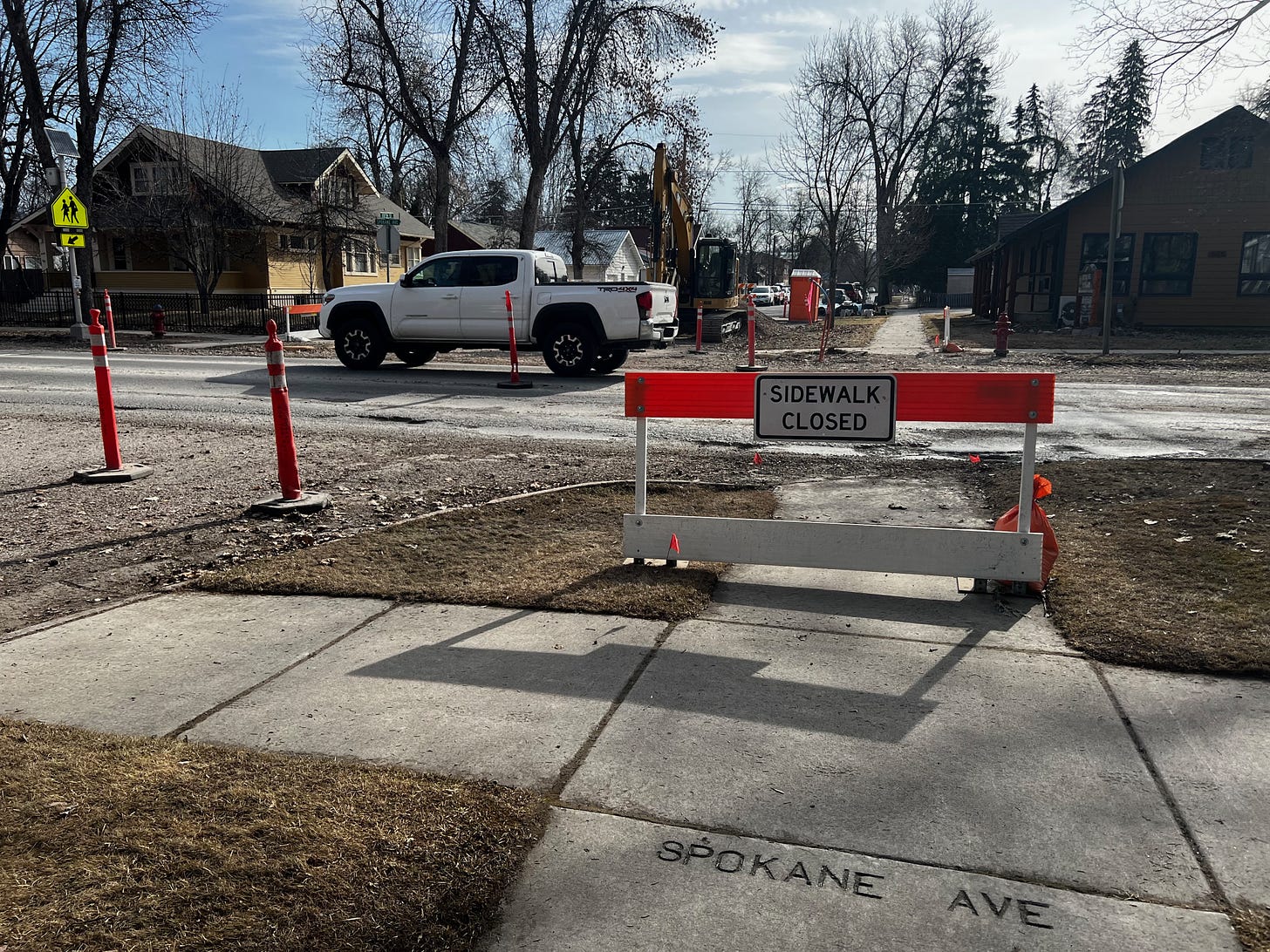


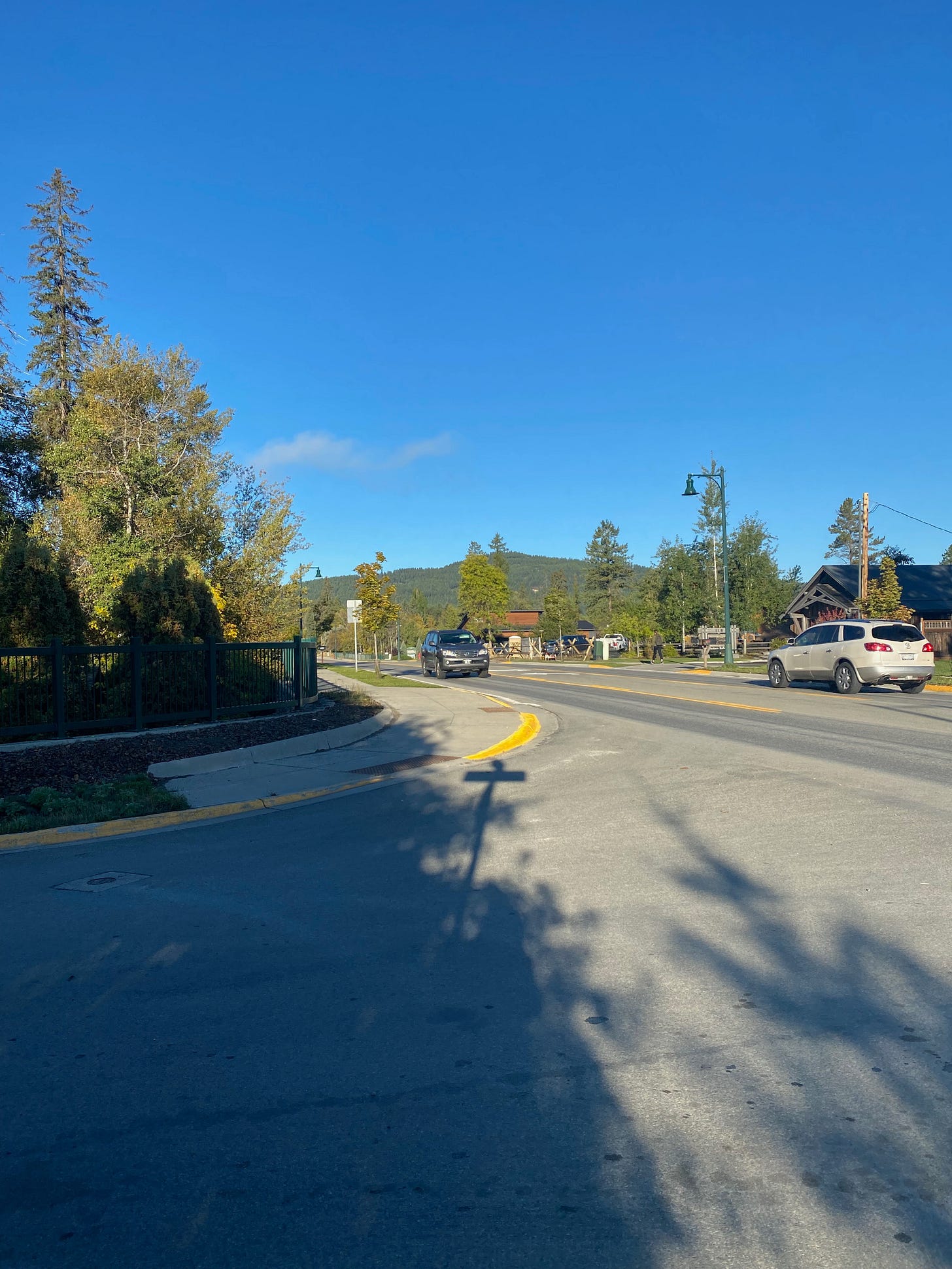

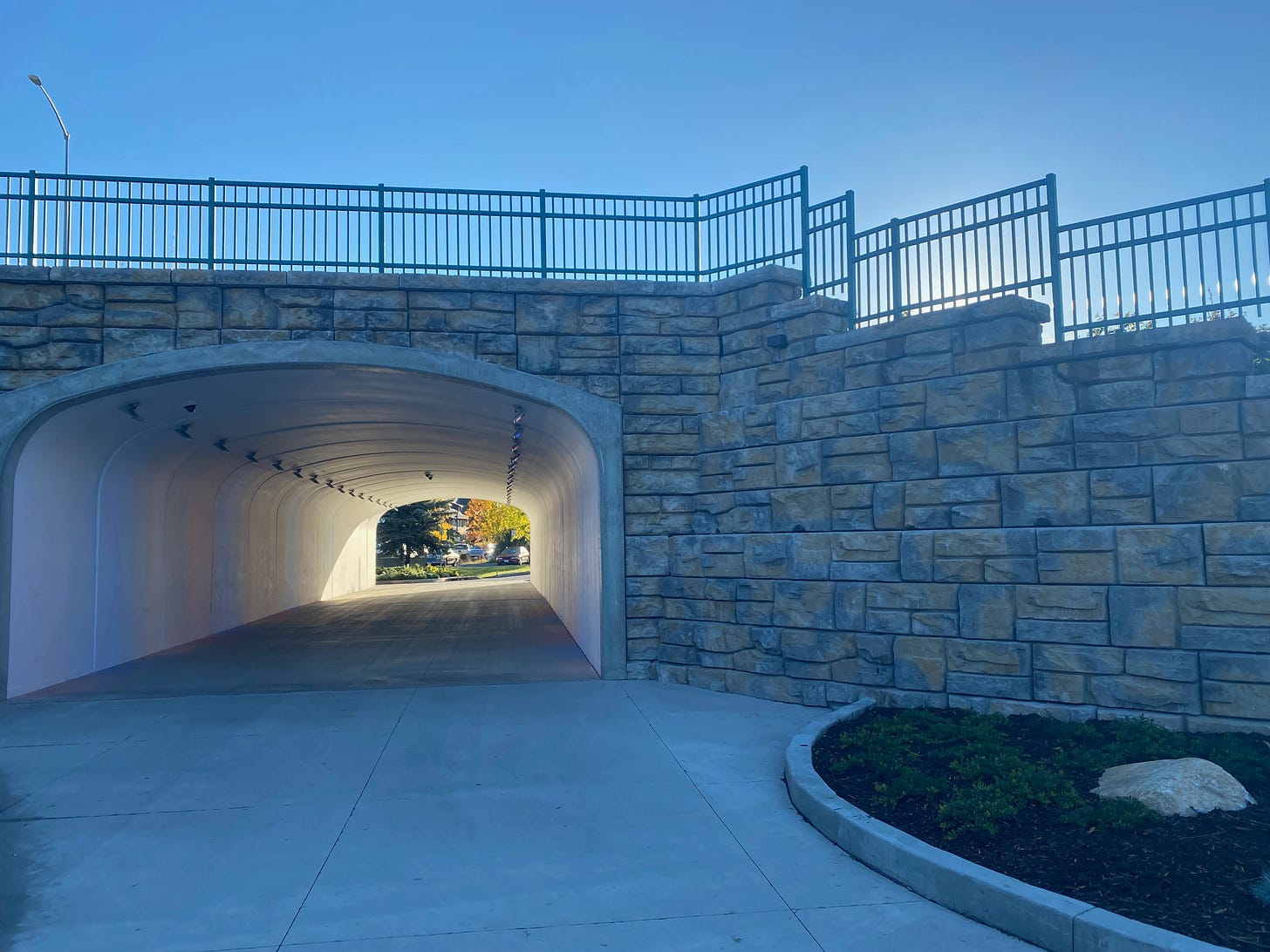
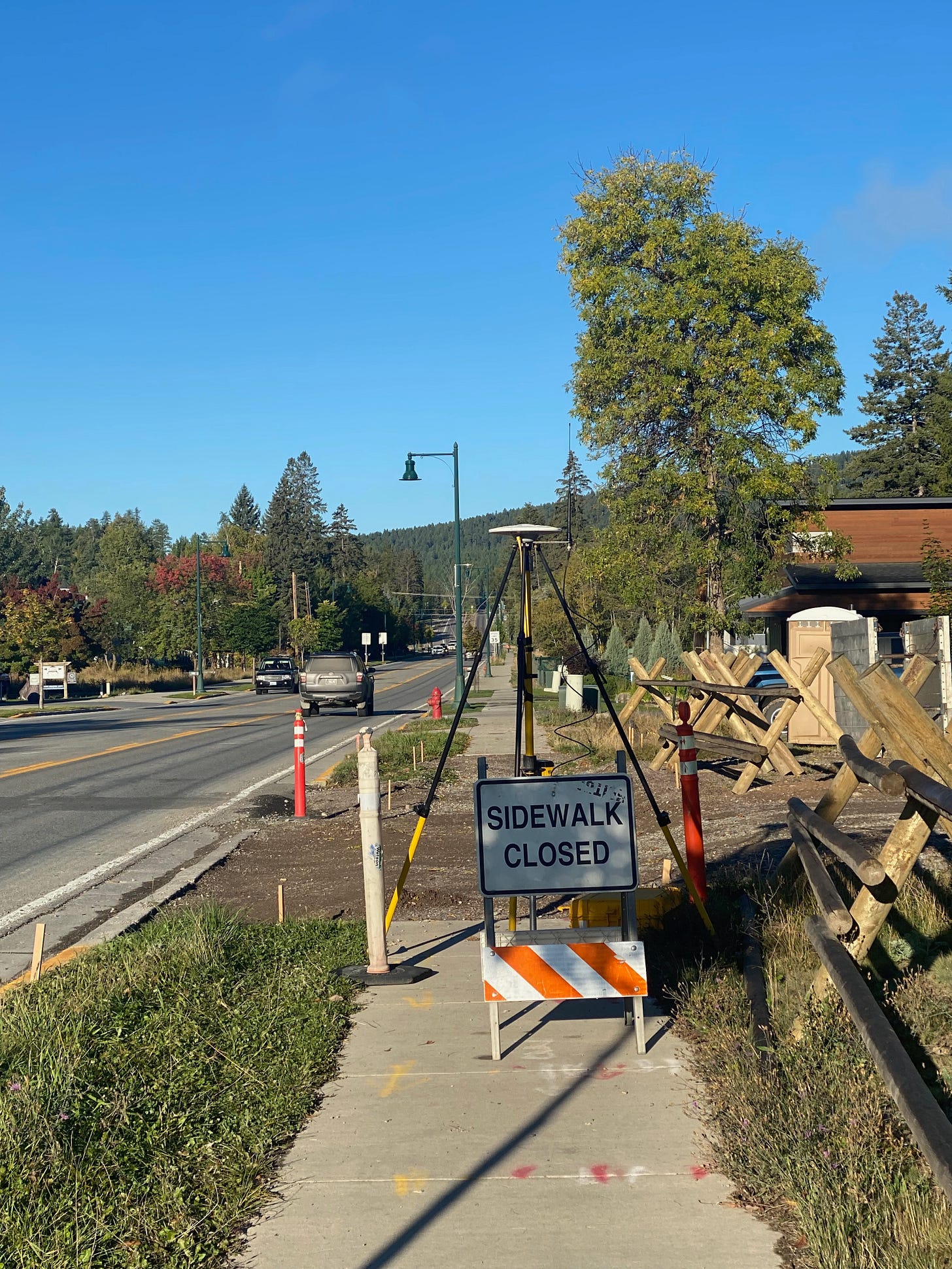
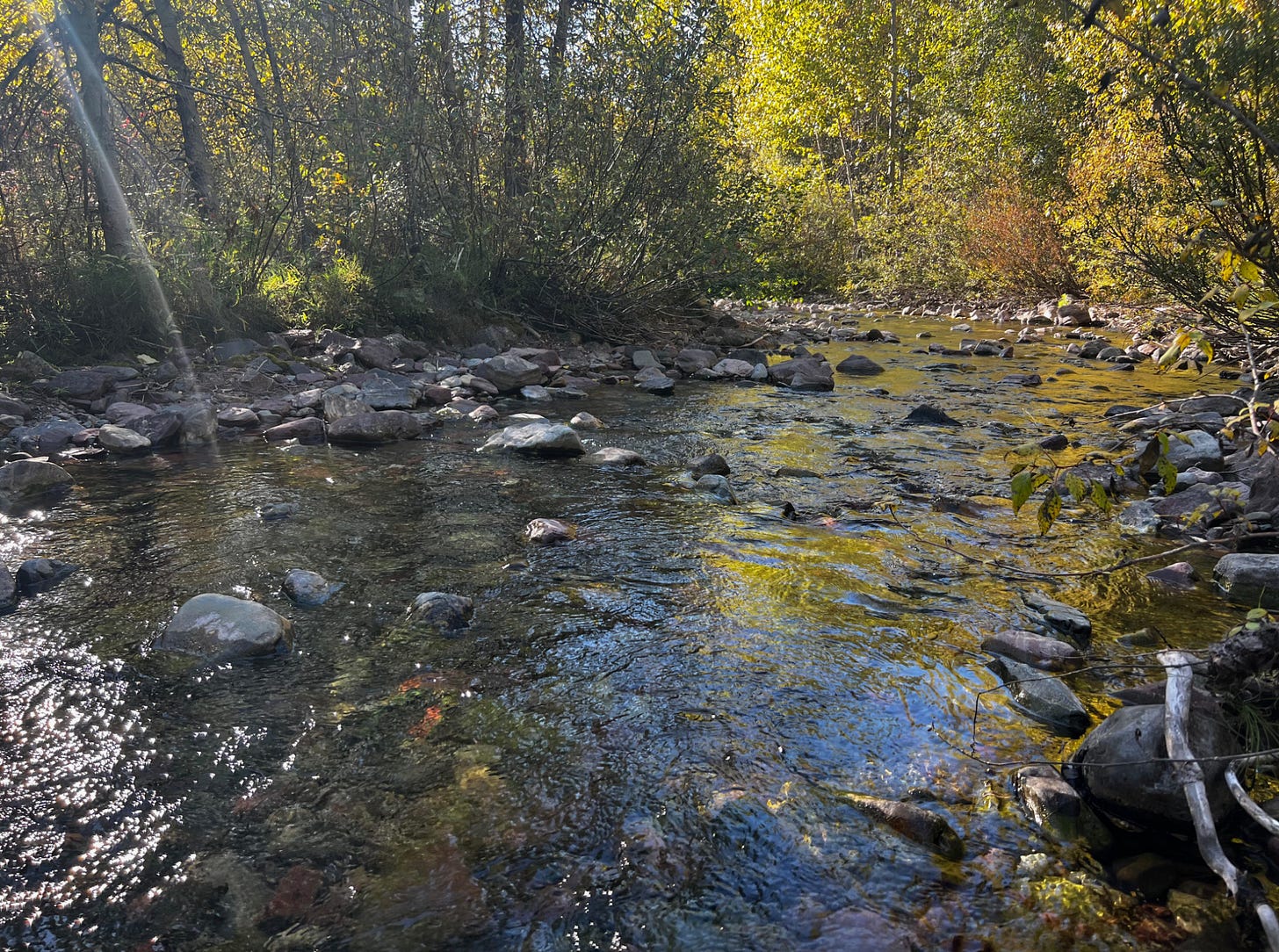
FYI
https://wapo.st/3AIU4BM
1) I absolutely LOVE scramble streets. So glad you brought that up.
B) We moved to Columbia, MO, about 7 years after the city received a $25M grant to make the place more walkable and bikable. Basically, we were able to get just about anywhere in a safe (and, generally, timely) via very safe bike path (or non-road adjacent trail) and it was phenomenal. Obviously the Arkansas summer makes foot-driven travel a bit more challenging, but I miss having that infrastructure all the time.
III) Have you taken a dive into these geniuses? https://thecityfix.com/blog/naked-streets-without-traffic-lights-improve-flow-and-safety/
As always, great shit!